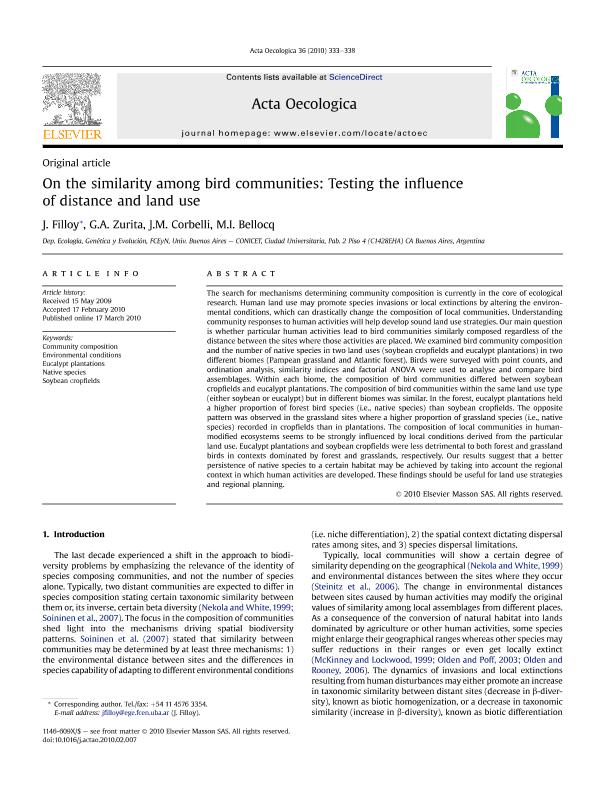Mostrar el registro sencillo del ítem
dc.contributor.author
Filloy, Julieta

dc.contributor.author
Zurita, Gustavo Andres

dc.contributor.author
Corbelli, Julián Martín

dc.contributor.author
Bellocq, Maria Isabel

dc.date.available
2018-08-30T17:38:15Z
dc.date.issued
2010-05
dc.identifier.citation
Filloy, Julieta; Zurita, Gustavo Andres; Corbelli, Julián Martín; Bellocq, Maria Isabel; On the similarity among bird communities: Testing the influence of distance and land use; Elsevier Masson; Acta Oecologica; 36; 3; 5-2010; 333-338
dc.identifier.issn
1146-609X
dc.identifier.uri
http://hdl.handle.net/11336/57719
dc.description.abstract
The search for mechanisms determining community composition is currently in the core of ecological research. Human land use may promote species invasions or local extinctions by altering the environmental conditions, which can drastically change the composition of local communities. Understanding community responses to human activities will help develop sound land use strategies. Our main question is whether particular human activities lead to bird communities similarly composed regardless of the distance between the sites where those activities are placed. We examined bird community composition and the number of native species in two land uses (soybean cropfields and eucalypt plantations) in two different biomes (Pampean grassland and Atlantic forest). Birds were surveyed with point counts, and ordination analysis, similarity indices and factorial ANOVA were used to analyse and compare bird assemblages. Within each biome, the composition of bird communities differed between soybean cropfields and eucalypt plantations. The composition of bird communities within the same land use type (either soybean or eucalypt) but in different biomes was similar. In the forest, eucalypt plantations held a higher proportion of forest bird species (i.e., native species) than soybean cropfields. The opposite pattern was observed in the grassland sites where a higher proportion of grassland species (i.e., native species) recorded in cropfields than in plantations. The composition of local communities in human-modified ecosystems seems to be strongly influenced by local conditions derived from the particular land use. Eucalypt plantations and soybean cropfields were less detrimental to both forest and grassland birds in contexts dominated by forest and grasslands, respectively. Our results suggest that a better persistence of native species to a certain habitat may be achieved by taking into account the regional context in which human activities are developed. These findings should be useful for land use strategies and regional planning.
dc.format
application/pdf
dc.language.iso
eng
dc.publisher
Elsevier Masson

dc.rights
info:eu-repo/semantics/openAccess
dc.rights.uri
https://creativecommons.org/licenses/by-nc-nd/2.5/ar/
dc.subject
Community Composition
dc.subject
Environmental Conditions
dc.subject
Eucalypt Plantations
dc.subject
Native Species
dc.subject
Soybean Cropfields
dc.subject.classification
Otras Ciencias Biológicas

dc.subject.classification
Ciencias Biológicas

dc.subject.classification
CIENCIAS NATURALES Y EXACTAS

dc.title
On the similarity among bird communities: Testing the influence of distance and land use
dc.type
info:eu-repo/semantics/article
dc.type
info:ar-repo/semantics/artículo
dc.type
info:eu-repo/semantics/publishedVersion
dc.date.updated
2018-08-30T14:45:08Z
dc.journal.volume
36
dc.journal.number
3
dc.journal.pagination
333-338
dc.journal.pais
Francia

dc.journal.ciudad
Paris
dc.description.fil
Fil: Filloy, Julieta. Universidad de Buenos Aires. Facultad de Ciencias Exactas y Naturales. Departamento de Ecología, Genética y Evolución; Argentina. Consejo Nacional de Investigaciones Científicas y Técnicas; Argentina
dc.description.fil
Fil: Zurita, Gustavo Andres. Universidad de Buenos Aires. Facultad de Ciencias Exactas y Naturales. Departamento de Ecología, Genética y Evolución; Argentina. Consejo Nacional de Investigaciones Científicas y Técnicas; Argentina
dc.description.fil
Fil: Corbelli, Julián Martín. Universidad de Buenos Aires. Facultad de Ciencias Exactas y Naturales. Departamento de Ecología, Genética y Evolución; Argentina. Consejo Nacional de Investigaciones Científicas y Técnicas; Argentina
dc.description.fil
Fil: Bellocq, Maria Isabel. Universidad de Buenos Aires. Facultad de Ciencias Exactas y Naturales. Departamento de Ecología, Genética y Evolución; Argentina. Consejo Nacional de Investigaciones Científicas y Técnicas; Argentina
dc.journal.title
Acta Oecologica

dc.relation.alternativeid
info:eu-repo/semantics/altIdentifier/doi/http://dx.doi.org/10.1016/j.actao.2010.02.007
dc.relation.alternativeid
info:eu-repo/semantics/altIdentifier/url/https://www.sciencedirect.com/science/article/pii/S1146609X10000305
Archivos asociados
